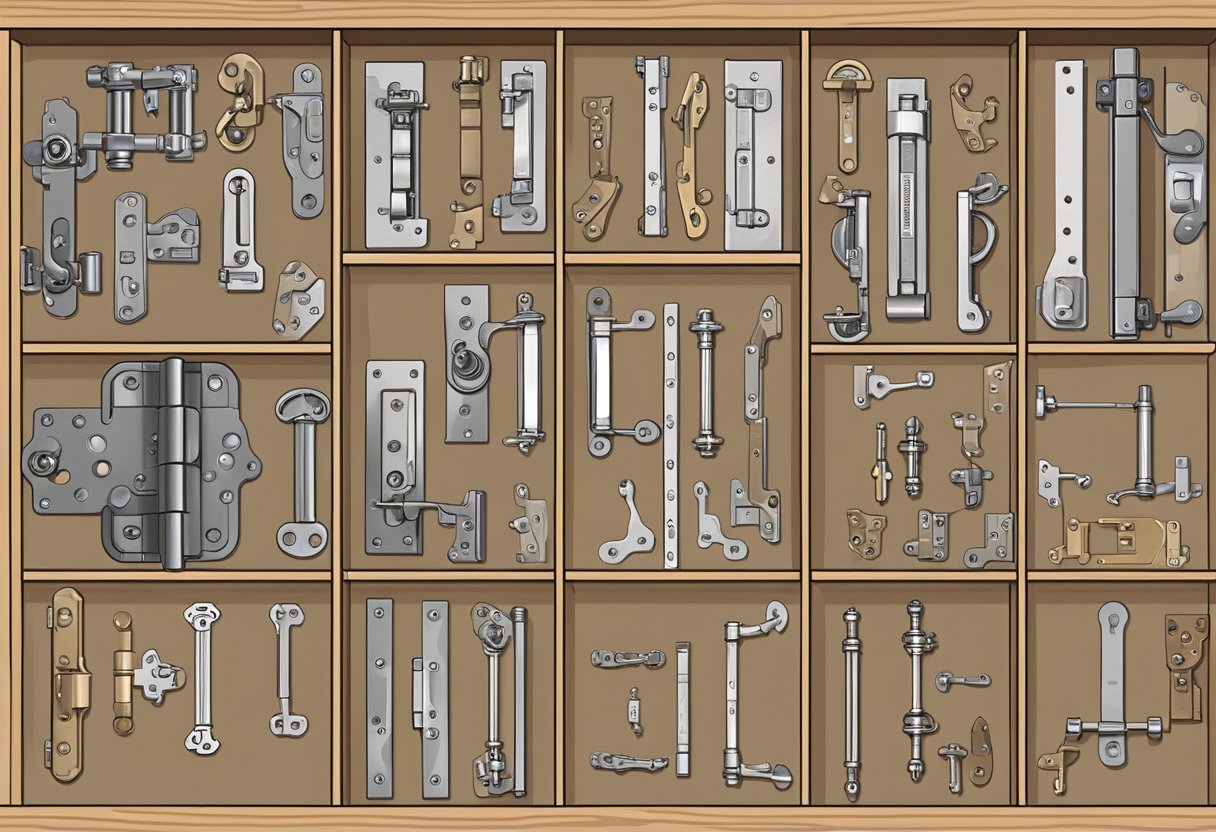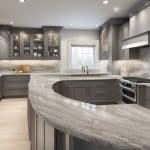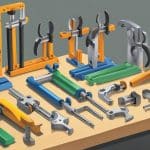Types Of Cabinet Hinges
Cabinet hinges are an essential component of cabinetry. They provide both aesthetic and functional value to cabinet doors. Understanding the different types of cabinet hinges available is important for selecting the right hinge for the cabinet door.

There are many types of cabinet hinges available in the market, including surface mount, semi-concealed, butt, inset, partial overlay, full overlay, flush, wrap around, T-style, and concealed hinges. Each type of hinge has its own unique features, benefits, and uses. For example, surface mount hinges are easy to install and adjust, while concealed hinges provide a clean and modern look to the cabinet door.
When selecting a hinge for a cabinet door, it is important to consider the cabinet style and the type of door being used. Additionally, hinge installation techniques should also be considered to ensure proper functionality of the cabinet door. Special features such as soft-close or self-closing mechanisms are also available in certain types of hinges.
Key Takeaways
- Understanding the different types of cabinet hinges available is important for selecting the right hinge for the cabinet door.
- When selecting a hinge for a cabinet door, it is important to consider the cabinet style and the type of door being used.
- Special features such as soft-close or self-closing mechanisms are also available in certain types of hinges.
Understanding Hinge Types
When it comes to cabinet hinges, there are several types to choose from. Each type of hinge has its own unique features and benefits. In this section, we will discuss some of the most common types of cabinet hinges and their uses.
Butt Hinges
Butt hinges are the most common type of hinge used on cabinet doors. They consist of two plates that are joined together by a pin. Butt hinges are easy to install and are available in a variety of sizes and finishes. They are also very durable and can withstand a lot of wear and tear.
Concealed Hinges
Concealed hinges are also known as European hinges. They are hidden from view when the cabinet door is closed, which gives the cabinet a sleek and modern look. Concealed hinges are adjustable, which makes them ideal for cabinets that are not perfectly square. They are also available in a variety of sizes and finishes.
Flush Hinges
Flush hinges are used on cabinets where the door is flush with the cabinet frame. They are available in both mortise and non-mortise versions. Flush hinges are easy to install and are available in a variety of sizes and finishes. They are also very durable and can withstand a lot of wear and tear.
Strap and Barrel Hinges
Strap and barrel hinges are decorative hinges that are used on cabinets where the door is inset into the frame. Strap hinges are designed to look like a strap, while barrel hinges are designed to look like a barrel. Both types of hinges are available in a variety of sizes and finishes. They are also very durable and can withstand a lot of wear and tear.
In summary, understanding the different types of cabinet hinges is important when choosing the right hinge for your cabinet. Butt hinges, concealed hinges, flush hinges, and strap and barrel hinges are just a few of the options available. Each type of hinge has its own unique features and benefits, so it is important to choose the right one for your specific needs.
Hinge Installation Techniques
When it comes to installing cabinet hinges, there are a few different techniques that can be used depending on the type of hinge and the cabinet door. The following subsections will cover some of the most common hinge installation techniques.
Surface Mounting
Surface mounting is one of the most common hinge installation techniques. This involves attaching the hinge to the surface of the cabinet door and the cabinet frame. Surface mount hinges are typically used on inset cabinet doors and partial overlay cabinet doors.
To install surface mount hinges, the cabinet door and cabinet frame must be properly aligned. The hinge should be attached to the cabinet door first, using screws and a screwdriver. The hinge can then be attached to the cabinet frame in the same way.
Mortising
Mortising is another hinge installation technique that is commonly used. This involves cutting a mortise, or recess, into the cabinet door and cabinet frame to allow the hinge to sit flush with the surface. Mortising is typically used on full overlay cabinet doors.
To install mortised hinges, the mortise must be cut into the cabinet door and cabinet frame first. This can be done using a drill and a mortising bit. The hinge can then be attached to the door and frame using screws and a screwdriver.
Adjusting and Alignment
Once the hinges have been installed, it is important to adjust and align them properly. This will ensure that the cabinet doors open and close smoothly and that they are properly aligned with the cabinet frame.
To adjust and align hinges, the screws on the hinges can be loosened or tightened as needed. This will allow the hinge to be moved slightly to adjust the alignment of the cabinet door. A level can be used to ensure that the cabinet door is properly aligned with the cabinet frame.
In conclusion, there are a few different hinge installation techniques that can be used depending on the type of hinge and the cabinet door. Surface mounting and mortising are two of the most common techniques, and adjusting and alignment are important steps to ensure that the cabinet doors open and close smoothly.
Hinge Selection for Cabinet Styles
When it comes to selecting the right hinge for your cabinets, it is important to consider the style of the cabinet itself. Different styles of cabinets require different types of hinges to ensure proper function and durability. In this section, we will discuss the hinge selection process for three common cabinet styles: face frame cabinets, frameless cabinets, and cabinets with inset and overlay doors.
Face Frame Cabinets
Face frame cabinets have a frame that runs along the front of the cabinet box, creating a lip around the opening. This style of cabinet requires hinges that attach to both the cabinet box and the face frame. Full overlay hinges are commonly used for face frame cabinets, as they allow the door to completely cover the face frame and provide a seamless look. Partial overlay hinges can also be used for face frame cabinets, but they will leave a small gap between the door and the face frame.
Frameless Cabinets
Frameless cabinets, also known as European-style cabinets, do not have a face frame. Instead, the doors are attached directly to the cabinet box. This style of cabinet requires hinges that attach only to the cabinet box. Full overlay hinges are typically used for frameless cabinets, as they allow the door to completely cover the cabinet box and provide a clean, modern look.
Inset and Overlay Doors
Cabinets with inset and overlay doors can be either face frame or frameless. Inset doors are set inside the cabinet frame, creating a flush surface when closed. Overlay doors, on the other hand, cover the entire cabinet opening and frame. The type of hinge used for these doors will depend on the style of the cabinet and the amount of overlay required. For face frame cabinets with inset doors, inset hinges are typically used. For face frame cabinets with overlay doors, flush mount, surface mount, and full overlay hinges are commonly used. For frameless cabinets with inset or overlay doors, full overlay hinges are typically used.
In summary, selecting the right hinge for your cabinets is crucial for ensuring proper function and durability. When selecting a hinge, it is important to consider the style of the cabinet, including whether it has a face frame or is frameless, and whether it has inset or overlay doors. By taking these factors into consideration, you can ensure that your cabinets will function properly and look great for years to come.
Specialty Hinges and Features
Cabinet hinges come in a variety of types, and some of them offer special features that can make a big difference in the functionality and appearance of your cabinets. In this section, we will discuss three types of specialty hinges: soft-close hinges, pivot hinges, and decorative hinges.
Soft-Close Hinges
Soft-close hinges are a popular choice for homeowners who want a quieter and more controlled closing of their cabinet doors. These hinges use a hydraulic mechanism that slows down the closing action of the door, preventing it from slamming shut and reducing the risk of damage to the door or the cabinet frame. Soft-close hinges are available in a variety of styles and sizes, and they can be used for both framed and frameless cabinets.
Pivot Hinges
Pivot hinges are a type of hinge that allows the cabinet door to pivot on a central point, rather than swinging on a fixed hinge pin. Pivot hinges are often used for tall, narrow cabinet doors, or for doors that are inset into the cabinet frame. They offer a unique look and can be used to create a variety of different styles, from modern to traditional.
Decorative Hinges
Decorative hinges are designed to be both functional and aesthetically pleasing. They can be used to add a touch of style and personality to your cabinets, and they come in a wide variety of designs, finishes, and sizes. Some decorative hinges are self-closing or spring-loaded, while others offer unique hinge features such as concealed mounting or adjustable tension.
In conclusion, choosing the right type of cabinet hinge is an important decision that can have a big impact on the functionality and appearance of your cabinets. By considering the features and benefits of each type of hinge, you can make an informed decision that meets your needs and preferences.
Materials and Finishes
When it comes to cabinet hinges, the material and finish play a crucial role in determining the durability and aesthetic appeal of the hardware. Different materials have different properties that affect their performance and lifespan. Some of the common materials used for making cabinet hinges include stainless steel, copper, and chrome.
Stainless steel is a popular choice for cabinet hinges due to its durability, corrosion resistance, and strength. It is also easy to clean and maintain, making it a suitable material for kitchen and bathroom cabinets. However, stainless steel hinges can be expensive compared to other materials.
Copper hinges are another option for those looking for a rustic or vintage look. They are durable and resistant to rust, but they require regular cleaning and polishing to maintain their shine. Copper hinges are available in different finishes, including antique, brushed, and polished.
Chrome hinges are known for their sleek and modern appearance. They are durable, easy to clean, and resistant to rust and tarnish. Chrome hinges are available in different finishes, including polished, brushed, and satin.
Apart from the material, the finish of the cabinet hinge can also affect its appearance and durability. Some of the common finishes for cabinet hinges include brass, nickel, and oil-rubbed bronze.
Brass finishes are popular for their warm and luxurious appearance. They are available in different shades, including antique, polished, and satin. Brass finishes can be prone to tarnishing and require regular cleaning and polishing.
Nickel finishes are known for their durability and resistance to rust and tarnish. They are available in different shades, including brushed, polished, and satin. Nickel finishes are easy to clean and maintain, making them a popular choice for kitchen and bathroom cabinets.
Oil-rubbed bronze finishes are popular for their rustic and vintage appearance. They are durable and resistant to rust and tarnish. Oil-rubbed bronze finishes require regular cleaning and maintenance to maintain their appearance.
In summary, the material and finish of the cabinet hinge play a crucial role in determining its durability and aesthetic appeal. It is essential to choose a material and finish that suits the design and function of the cabinet.






